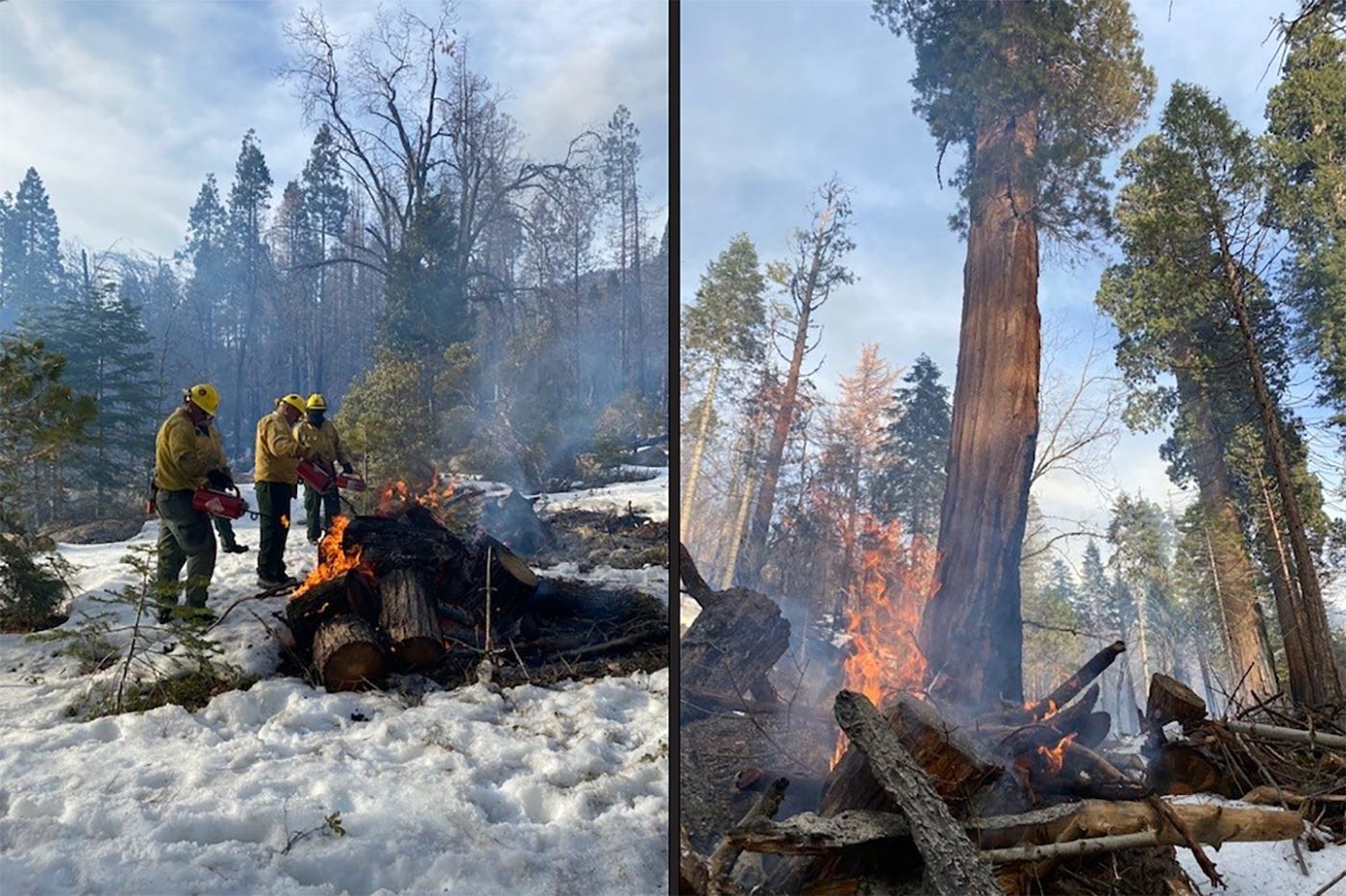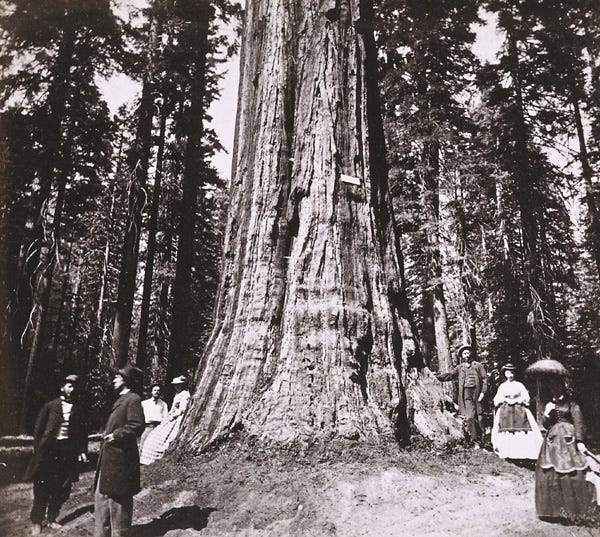Giving giant sequoia groves the ‘one-two punch’
Crews continue burning piles as part of emergency response
Volume 1, Number 28 - Monday, Feb. 20, 2023
Now twice a week — Monday and Thursday mornings!

Perspective
LAST SUMMER, over the roar of buzzing chainsaws in giant sequoia groves on Sequoia and Sierra national forests, Gretchen Fitzgerald, ecosystem staff officer for Sequoia National Forest, explained that the “mechanical treatment," or thinning, would be followed by burning.
Throughout the 12 groves included in the giant sequoia emergency response, crews hustled through the late summer and early fall to pull massive amounts of vegetation away from the bases of the mammoth trees. Trees — some dead, some not — were felled and cut into pieces and added to burn piles.
Between snowstorms — and there have been plenty this winter — crews are torching those piles. There were thousands of piles of logs and brush and slowly they’re being reduced to ash.
Ignitions are dispersed to avoid heating, damaging roots, or scorching nearby live sequoias or other conifers, the Forest Service explained in a news release. And personnel work closely with the San Joaquin Valley Air Pollution Control District to manage smoke production and reduce the impact on communities, roads and highways.
Although piles may smolder and burn for several days, crews will monitor them until they are declared out, the agency said. Monitoring includes ensuring that fire does not creep into nearby sequoia logs or stumps.
The point of the emergency response, which includes the burning taking place this winter as weather allows, is to reduce the fuel load in giant sequoia groves with the hope that they will better survive high intensity wildfires that have wiped out thousands of giant sequoia trees since 2015. (It bears repeating: about one-fifth of the mammoths have been killed in recent years, largely by wildfire).
The approach used as part of the emergency response is widely supported, although not without critics including Ara Marderosian of Sequoia ForestKeeper. The organization claims that the Forest Services uses the “false moniker of Hazard Tree and fuels reduction” for what is really logging that will ultimately harm the groves.
Emily Shepherd wrote about thinning in a recent edition of High Country News, a monthly magazine that covers environmental, social and political issues of the American West.
Her article HERE, “Does thinning work for wildfire prevention? The rundown on what scientists find actually works to protect forests and homes,” is worth your time. She interviews environmental historian Stephen Pyne, who tells her:
Thinning is not logging
Thinning does not make wildfires more destructive
Thinning is not a climate change risk
Thinning should be followed by prescribed fire: “If you don't follow it up with the right fire, then it's worthless, and in many cases may have made it worse,” said Pyne. Thinning and prescribed burning are the one-two punch that will knock out many severe wildfires.
There’s lots more of value in Shepherd’s article and I may write more about it in the future.
Meanwhile, every passing day brings us closer to the end of winter, new growth, increased temperatures and the inevitability of wildfire that may test the protections the Forest Service is hoping to provide.
Noteworthy
The National Park Service (NPS) is seeking public feedback on a proposal to replant giant sequoia and other mixed conifer seedlings in areas severely impacted by the recent Castle and KNP Complex wildfires and where regeneration is otherwise not anticipated in Sequoia and Kings Canyon National Parks. Read about it HERE and consider participating in the virtual meeting from 5 to 6 p.m. on Feb. 27.
Wildfire, water & weather update
Weather and drought update: More wet weather, with snow in the Sierra, is in the forecast for all of giant sequoia country this week. According to the U.S. Drought Monitor, most areas are still considered to be in moderate drought, but in the north, part of Placer and Calaveras counties — where Placer Big Trees grove and the Calaveras County groves are found — have improved to only “abnormally dry.”
Wildfire update: The latest Predictive Services Management Situation Report published HERE still shows National Preparedness Level 1 (which is good).
GS Lands Coalition progress
I’m continuing with reports from the Dec. 14, 2023, meeting of the Giant Sequoia Lands Coalition here, and this is my final report…
Many representatives of the Tule River Reservation were present at the coalition meeting last December and the tribe takes great pride in their forested lands. Here’s what was reported at the meeting: “The Tule River Indian Tribe of California stewards portions of or all of five giant sequoia groves. These groves include the Black Mountain, Red Hill, Peyrone, Parker Peak and Cold Springs groves.
“In 2022, the tribe continued its ongoing restoration efforts by treating approximately 400 acres of forestland using a combination of manual, mechanical, and prescribed fire methods. These treatments included erosion control, reforestation, hazard tree removal, and vegetation fuels reduction within and near grove boundaries. Reforestation efforts following the wildfire included the hand planting of 30,000 13 native conifer trees, including giant sequoias grown from seeds collected from Reservation sequoia trees.
“As in previous years, field work was completed by personnel employed by the Tule River Tribal Natural Resources Department. Approximately 22 experienced seasonal employees completed the 2022 restoration treatments.”
You can read the full coalition report here.
Did you know you can comment here?
It’s easy to comment on items in this newsletter. Just scroll down and you’ll find a comment box. You’re invited to join the conversation!
Giant sequoias in the news
• Here is an interesting article recently published on a website called The Travel that compares the General Sherman Tree with Utah’s Pando Aspen. The tagline: “While General Sherman is often said to be the largest tree in the world, a collection of puny aspens claims to be bigger.” Great photos help tell the story.
• There’s nothing specifically about giant sequoias in this analysis from Bloomberg that I came across in Washington Post except a wonderful photo of a mammoth tree in Long Meadow Grove, but the lead is intriguing and I can imagine the big trees helping clean the air: “The quest for climate solutions reached a critical turning point when scientists recently concluded that curbing the crisis will require more than just cutting emissions: We must vacuum out the carbon already pumped into the skies.” Read the full article HERE (gift link).
• Senators Dianne Feinstein and Alex Padilla (both D-Calif.) have again introduced legislation to formally recognize the Tule River Tribe’s reserved water rights and quantify the tribe’s water right of 5,828 acre-feet/year of surface water from the South Fork of the Tule River. This legislation was introduced last year but fizzled when the 117th Congress ended. Last year, the two senators introduced this legislation in September, only about a week after introducing their version of the “Save Our Sequoias Act.” But so far there’s no word on whether the House or Senate will bring the SOS legislation back for consideration.
Historic photo of the week
In honor of President’s Day I’m sharing this great photo of the Abraham Lincoln Tree in the North Grove at Calaveras Big Tree State Park. No, that’s not Honest Abe in the photo, but apparently someone who dressed up as the famous U.S. president for this special occasion which is believed to have taken place sometime in the late 1860s or 1870s. — Photographer not identified; image from the Lawrence & Houseworth Photography Albums, Society of California Pioneers via Online Archive of California
Giant sequoias around the world
Last November I reported that in 1975, Richard J. Hartesveldt and other authors of a book called “The Giant Sequoia of the Sierra Nevada,” had written about a giant sequoia in Norway that was among the most northerly in the world. At the time, I couldn’t find more information about that tree but happily I think it’s still growing. You can view a photo HERE of a giant sequoia planted in a rectory garden in Leikanger, a tiny Norwegian village. The tree was planted in 1870 and reportedly is still growing there.
Online index added
An online index to the Giant Sequoia News newsletters has been added. You’ll find it HERE.
Thanks for reading!





I think that the "right fire" is actually an entirely different kind of fire not what we're seeing with these big piles in the snow. I think it's more of a low intensity fire that creeps along the forest floor and in some cases makes conditions right for seedlings. The big pile burning is a combination of one of the cheaper ways to get the debris out of the forest, and in some cases the only way. I will follow up with Gretchen and see if I got that right. It is far more difficult for them to burn in other seasons because of the chance of the fire getting away.
Thanks for your work with the trees Claudia, I have a question: Is prescribed burning done within the boundaries of a prescribed thinning? Or is the burning done in separate areas? What, and where is the “right fire”, which gives the process its “one two punch”, located? ~DWRichrdson